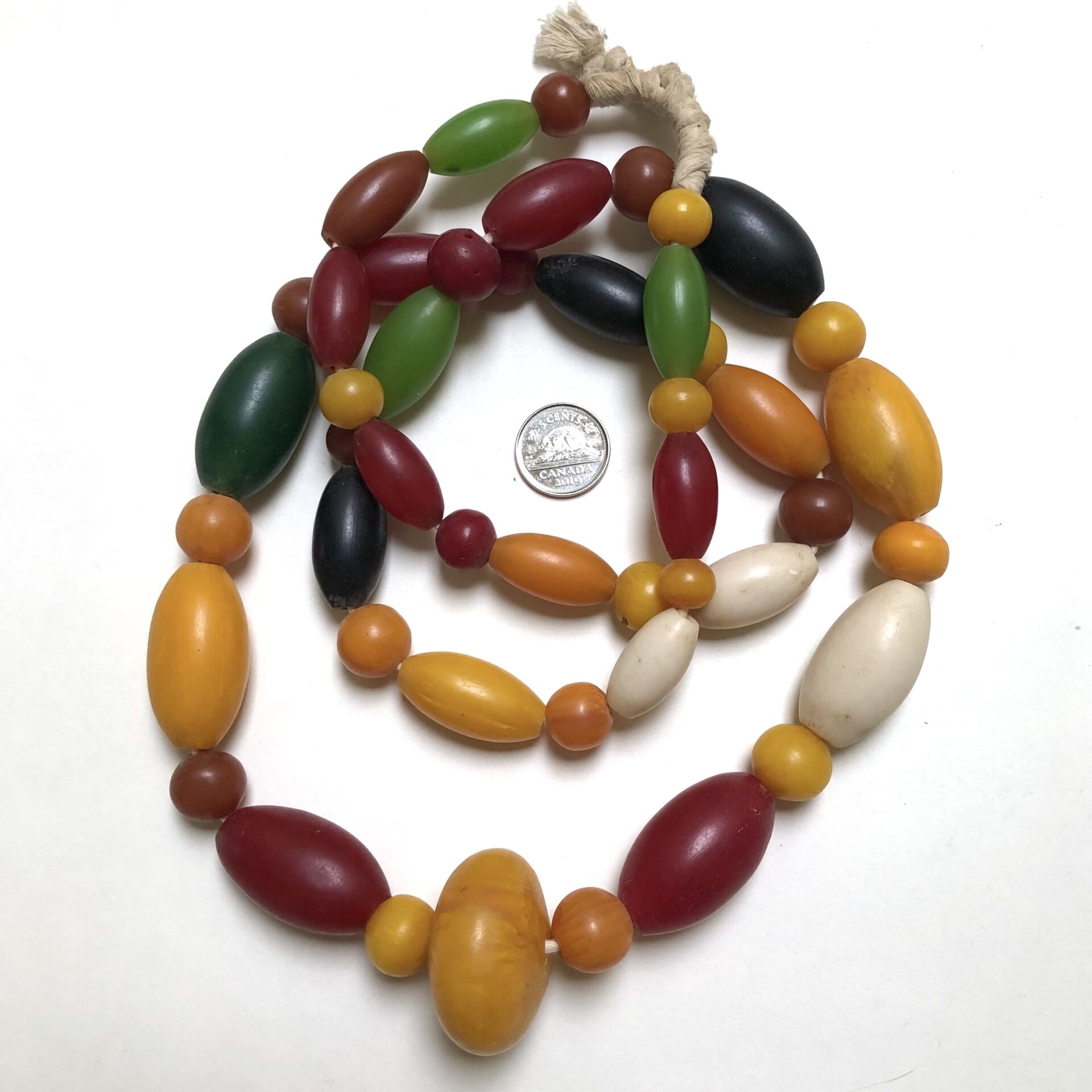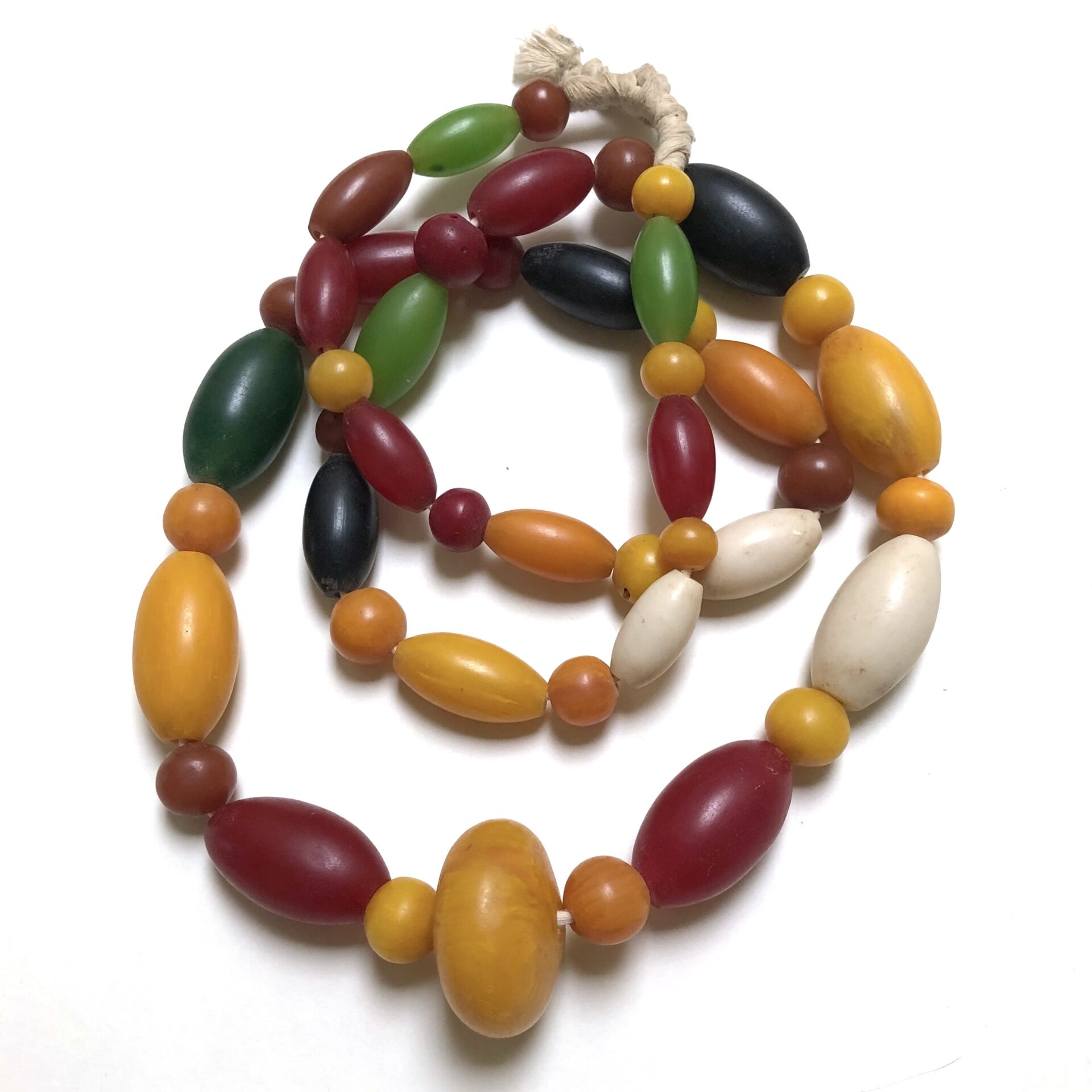-
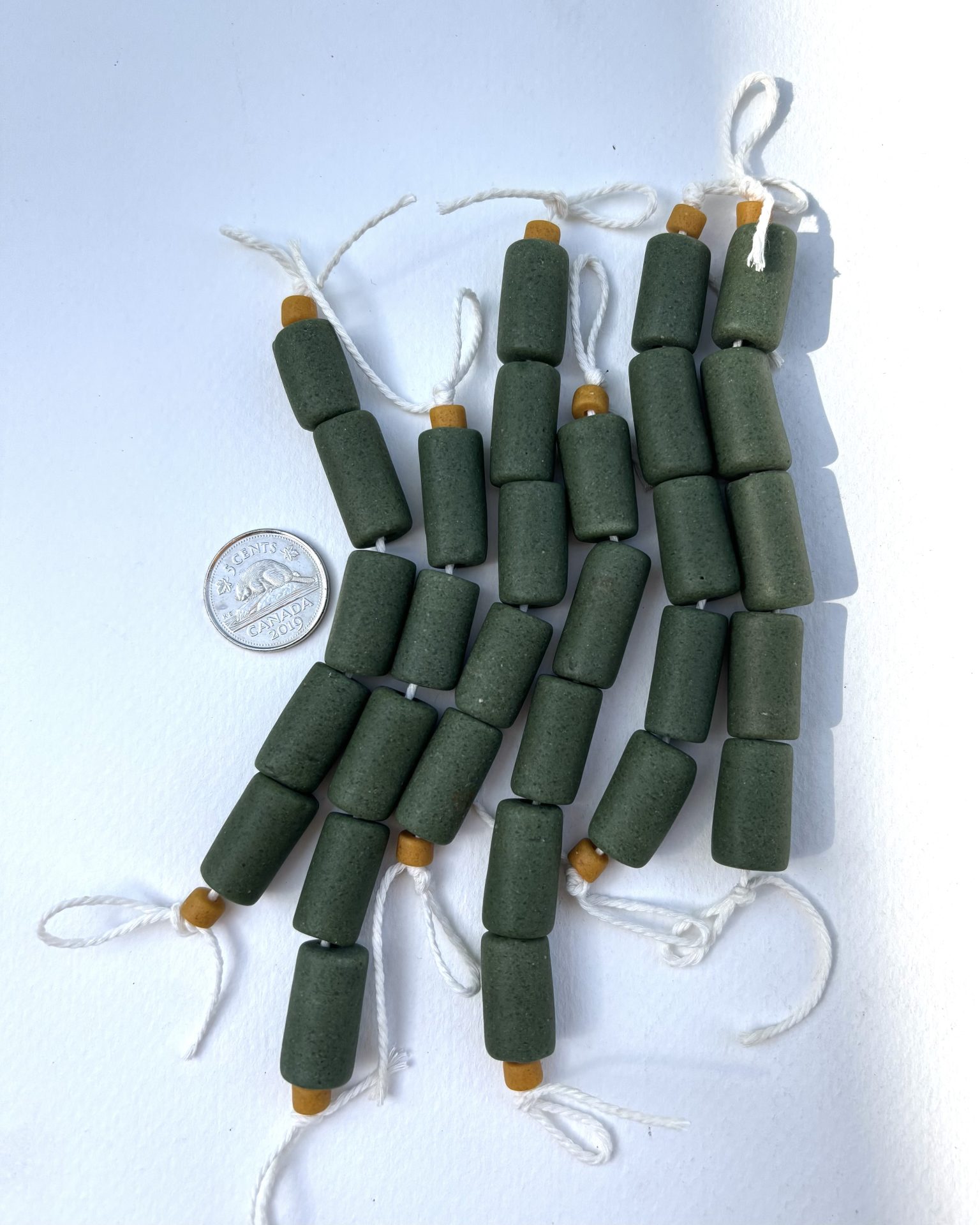
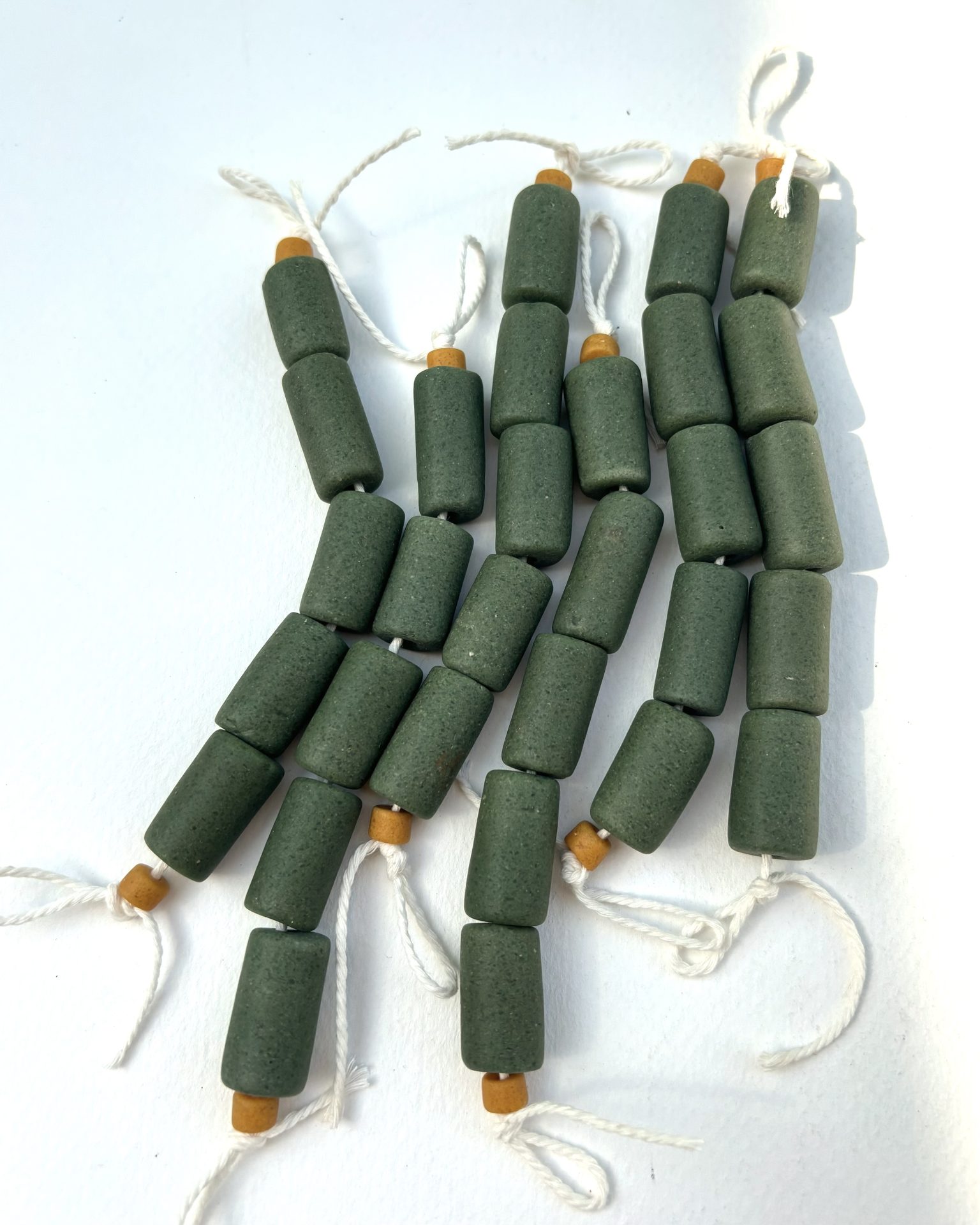 A strand of moss green glass beads with a velvety polished finish. These beads also come in a rainbow of other colours displayed separately. The 27 tube shaped beads are strung on string 23'' long. These beads vary in size as they are handmade. Each bead is around 22 mm x 9 mm. Funky Frog acquired these beads directly from the small factory in Accra which hand makes these beads. If you would like to have just a few beads please contact us … each bead is .45 … and remember the sixth bead is ‘free’! $2.25/6beads
A strand of moss green glass beads with a velvety polished finish. These beads also come in a rainbow of other colours displayed separately. The 27 tube shaped beads are strung on string 23'' long. These beads vary in size as they are handmade. Each bead is around 22 mm x 9 mm. Funky Frog acquired these beads directly from the small factory in Accra which hand makes these beads. If you would like to have just a few beads please contact us … each bead is .45 … and remember the sixth bead is ‘free’! $2.25/6beads -

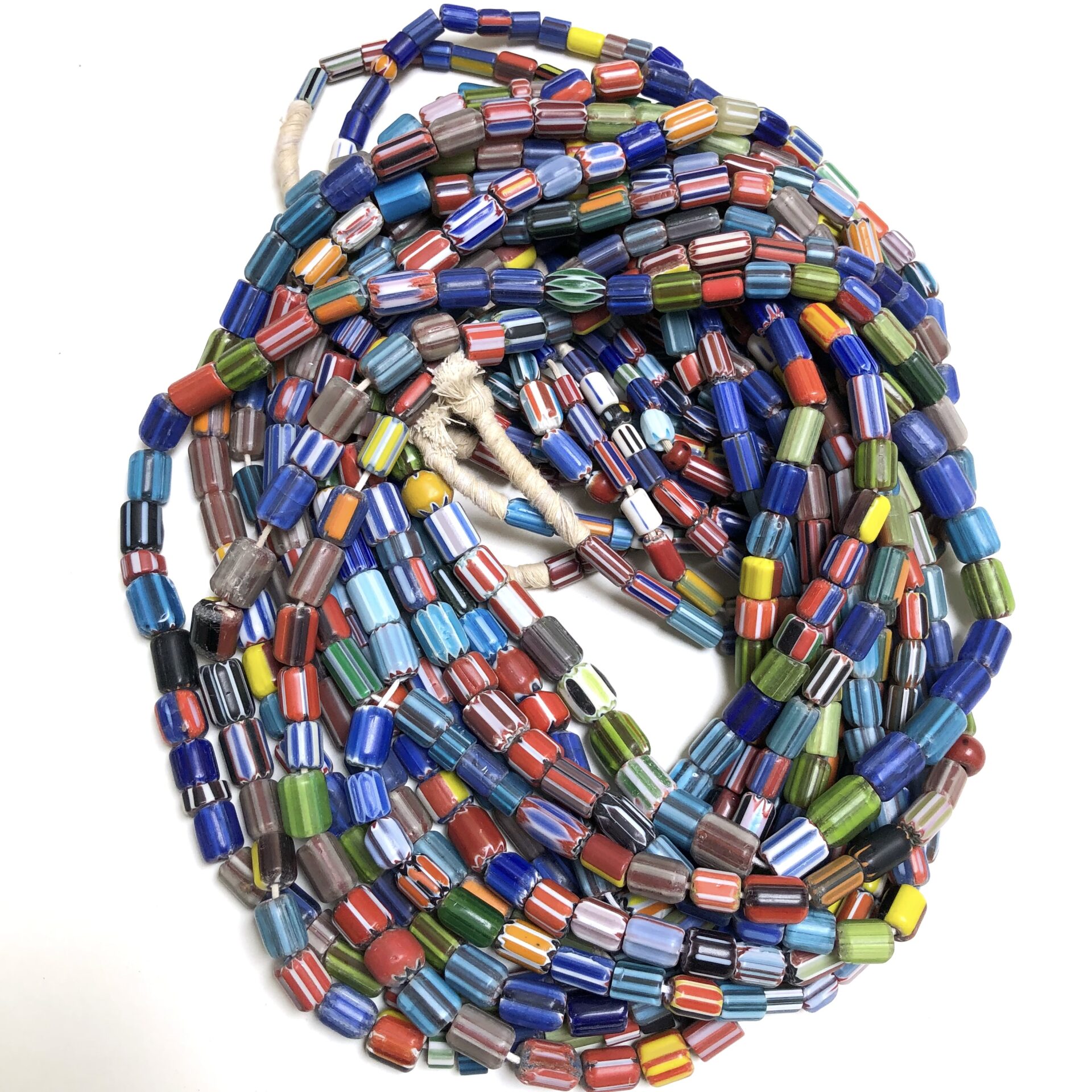 A strand of assorted Chevron Beads on string 34" long. The beads vary in size, colour and shape. ' Venetian chevron beads have been traded throughout the world, most heavily in West Africa, where they were first introduced by Dutch merchants in the late 15th century. ' (wikipedia) You will receive a strand similar to the ones in the photo. .55/bead ... if you would like only several beads please contact us ...
A strand of assorted Chevron Beads on string 34" long. The beads vary in size, colour and shape. ' Venetian chevron beads have been traded throughout the world, most heavily in West Africa, where they were first introduced by Dutch merchants in the late 15th century. ' (wikipedia) You will receive a strand similar to the ones in the photo. .55/bead ... if you would like only several beads please contact us ... -

 A strand of 175 small green button-like Prosser Beads on raffia 26" long. Each bead is about 7 mm in diameter. These are great spacer beads. Prosser beads are by extension any beads made by the 'Prosser' technique, invented by the Prosser brothers in 1840 in England for the purpose of making buttons. The process consists of molding a cold paste under great pressure and then firing it.
A strand of 175 small green button-like Prosser Beads on raffia 26" long. Each bead is about 7 mm in diameter. These are great spacer beads. Prosser beads are by extension any beads made by the 'Prosser' technique, invented by the Prosser brothers in 1840 in England for the purpose of making buttons. The process consists of molding a cold paste under great pressure and then firing it. -

 A strand of opaque dark green Rondelle Recycled Glass beads on string 22" long. These recycled beads were bought directly from the small factory in Accra, Ghana where the artisans hand make the beads in the labor intensive method of their ancestors from crushing glass to baking the final product in wood ovens.
A strand of opaque dark green Rondelle Recycled Glass beads on string 22" long. These recycled beads were bought directly from the small factory in Accra, Ghana where the artisans hand make the beads in the labor intensive method of their ancestors from crushing glass to baking the final product in wood ovens. -

 A strand of about 27 tube shaped Recycled Glass Beads on string 24" long. There is a range of colours, textures, colours and shapes! You will receive a strand similar to the one in the photo with some variations. Ghana is famous for these recycled beads made from recycled glass bottles. These recycled beads were bought directly from the small factory in Accra, Ghana where the artisans hand make the beads in the labor intensive method of their ancestors from crushing glass to baking the final product in wood ovens. Please note the strand you will receive will be similar to the strand in the photo. There will be variations as the strand is hand strung and handmade.
A strand of about 27 tube shaped Recycled Glass Beads on string 24" long. There is a range of colours, textures, colours and shapes! You will receive a strand similar to the one in the photo with some variations. Ghana is famous for these recycled beads made from recycled glass bottles. These recycled beads were bought directly from the small factory in Accra, Ghana where the artisans hand make the beads in the labor intensive method of their ancestors from crushing glass to baking the final product in wood ovens. Please note the strand you will receive will be similar to the strand in the photo. There will be variations as the strand is hand strung and handmade. -

 A strand of 107 small Sandcast Recycled Glass Beads strung on raffia 36" long. The beads are between 5-7x7 mm and are a mix of colours; green, yellow and red. These Sandcast Beads beads were handcrafted in Ghana, Africa by crushing old, discarded glass, adding colorant and then pouring the powder into clay molds. The stem of a local plant is added, this burns away during firing, leaving a hole for stringing. The beads are fired in a woodburning earthen oven. Ghana is famous for this type of bead.
A strand of 107 small Sandcast Recycled Glass Beads strung on raffia 36" long. The beads are between 5-7x7 mm and are a mix of colours; green, yellow and red. These Sandcast Beads beads were handcrafted in Ghana, Africa by crushing old, discarded glass, adding colorant and then pouring the powder into clay molds. The stem of a local plant is added, this burns away during firing, leaving a hole for stringing. The beads are fired in a woodburning earthen oven. Ghana is famous for this type of bead. -

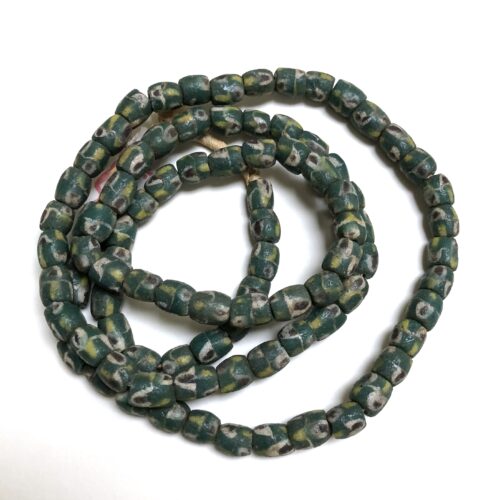 A strand of 91 Sandcast Recycled Glass Beads strung on raffia 36" long. The beads are around 8 mm and are a mix of colours; green, white and black. These recycled glass beads were handcrafted in Ghana, Africa by crushing old, discarded glass,, adding colorant and then pouring the powder into clay molds. The stem of a local plant is added, this burns away during firing, leaving a hole for stringing. The beads are fired in a woodburning earthen oven. Ghana is famous for this type of bead.
A strand of 91 Sandcast Recycled Glass Beads strung on raffia 36" long. The beads are around 8 mm and are a mix of colours; green, white and black. These recycled glass beads were handcrafted in Ghana, Africa by crushing old, discarded glass,, adding colorant and then pouring the powder into clay molds. The stem of a local plant is added, this burns away during firing, leaving a hole for stringing. The beads are fired in a woodburning earthen oven. Ghana is famous for this type of bead. -
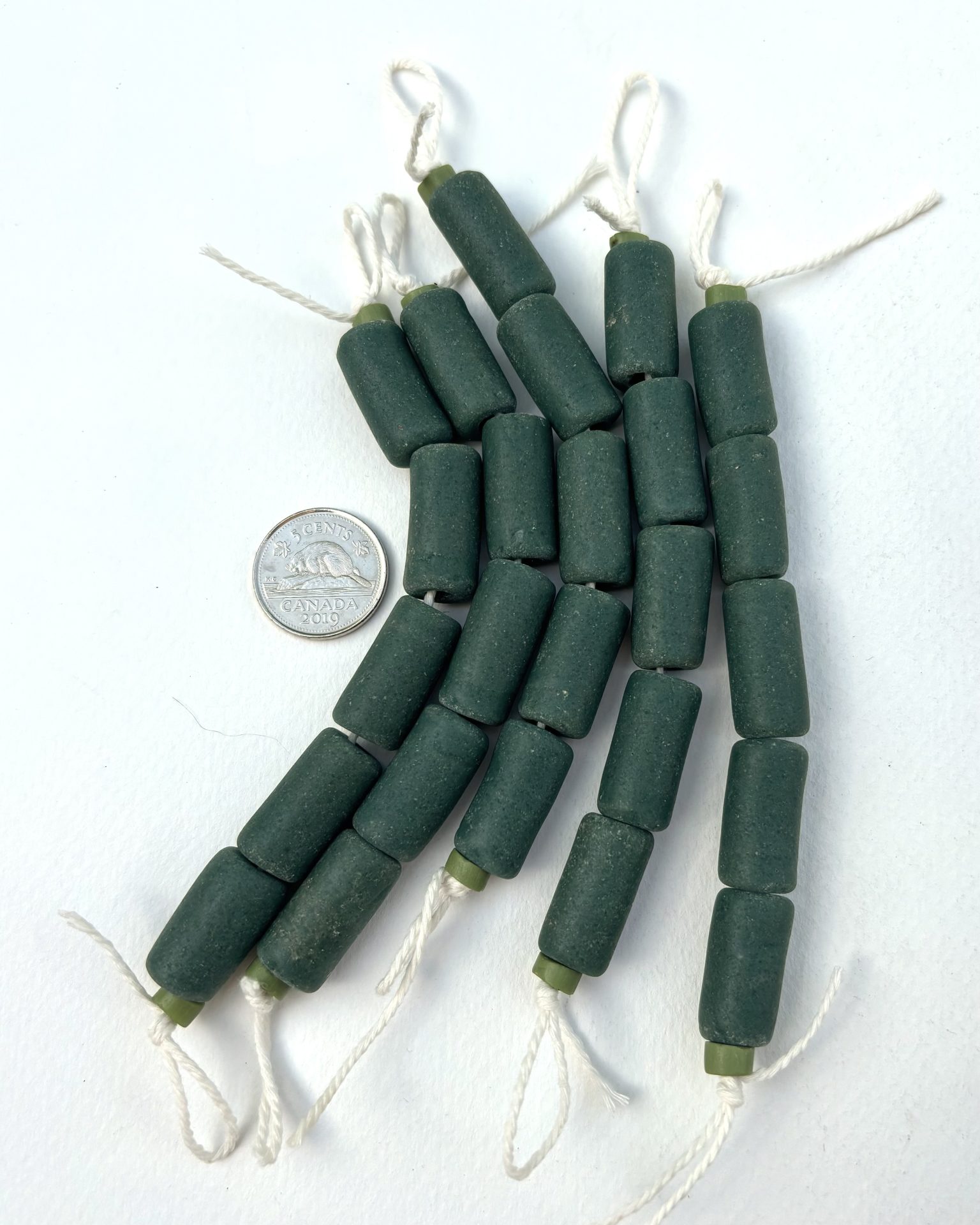
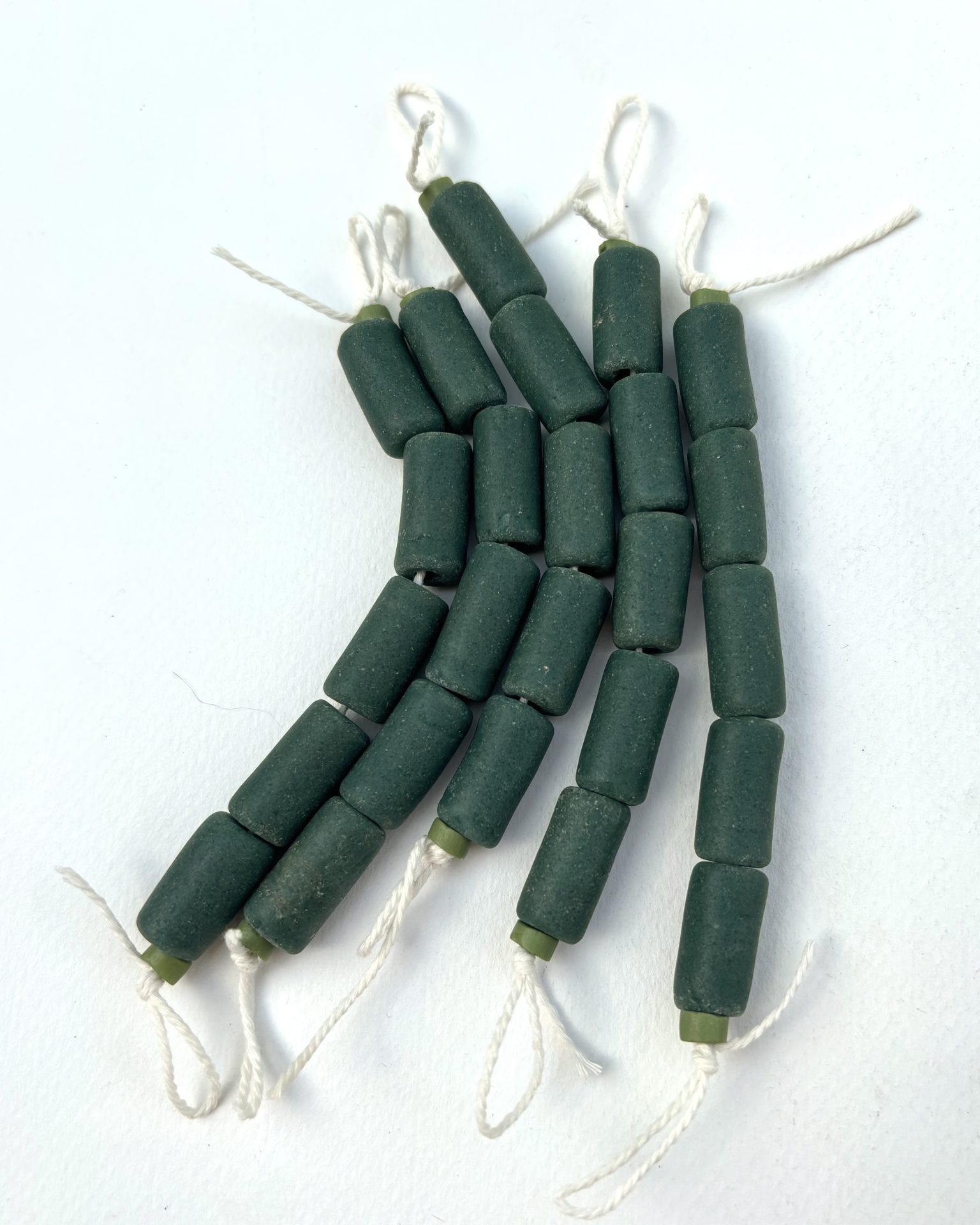 5 forest green Tubular Recycled Glass Beads with a velvety polished finish. These beads vary in size as they are handmade. Each bead is around 22 mm x 9 mm. Funky Frog acquired these beads directly from the small factory in Accra which hand makes these beads. These beads make great accents adding colour and interest. $3/5 beads
5 forest green Tubular Recycled Glass Beads with a velvety polished finish. These beads vary in size as they are handmade. Each bead is around 22 mm x 9 mm. Funky Frog acquired these beads directly from the small factory in Accra which hand makes these beads. These beads make great accents adding colour and interest. $3/5 beads -

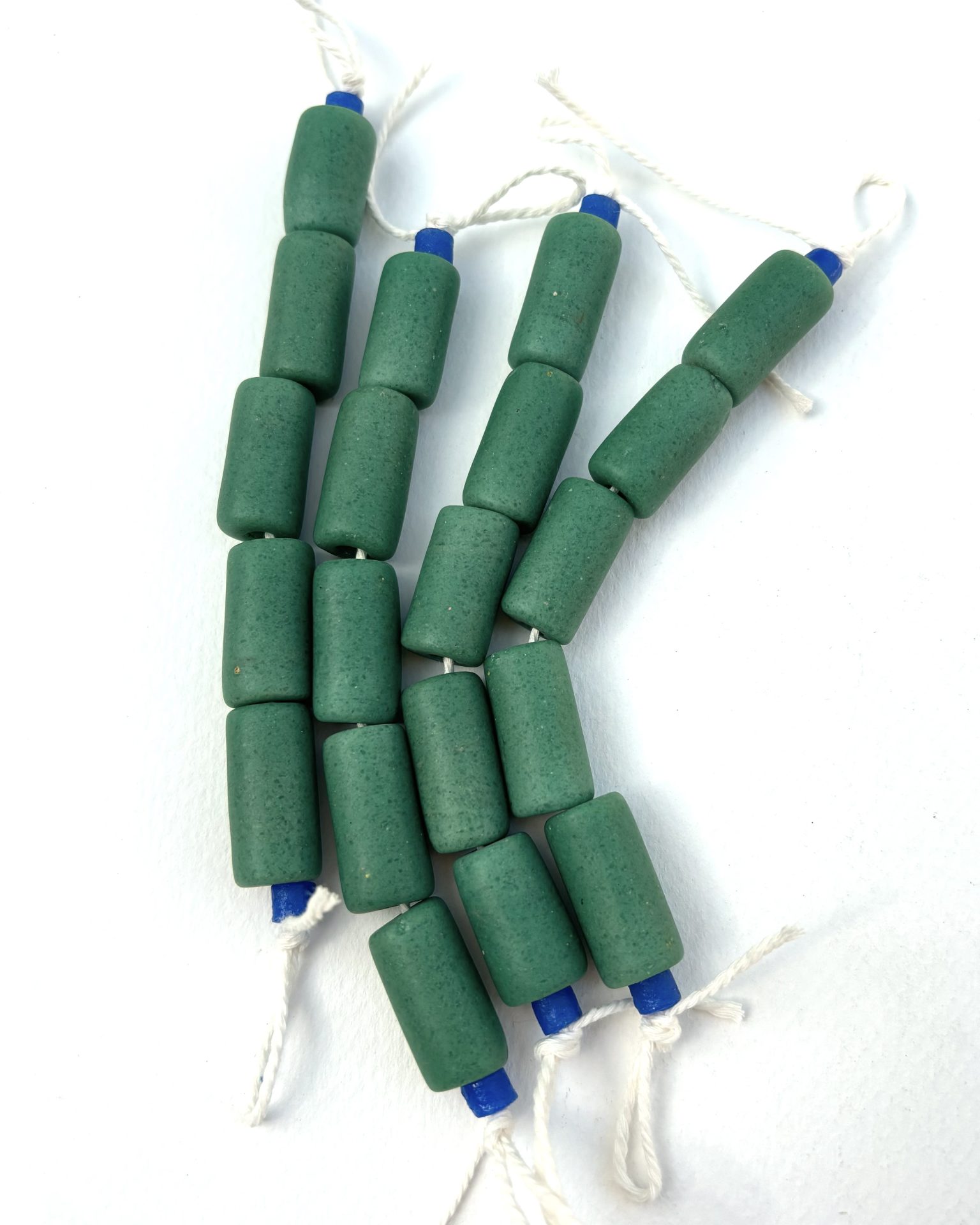 5 Lawn Green Tubular Recycled Glass Beads with a velvety polished finish. These beads vary in size as they are handmade. Each bead is around 22 mm x 9 mm. Funky Frog acquired these beads directly from the small factory in Accra which hand makes these beads. These beads are a great accent beads adding interest to any project. $3 / 5 beads
5 Lawn Green Tubular Recycled Glass Beads with a velvety polished finish. These beads vary in size as they are handmade. Each bead is around 22 mm x 9 mm. Funky Frog acquired these beads directly from the small factory in Accra which hand makes these beads. These beads are a great accent beads adding interest to any project. $3 / 5 beads -

 A strand of about 97 translucent dark green
A strand of about 97 translucent dark greenRecycled Glass Beads in the shape of a tear drop strung on string 21" long. These translucent beads are about 10x15 mm. These beads are handmade so will vary in size and shape and even colour. These recycled glass beads were purchased straight from the small factory which hand crafts them using the methods of their ancestors, from crushing recycled bottles all the way to firing them in a wood burning oven. -

 2 bracelet sized strands of 22 tubular Sandcast Beads strung on string 10" long. The beads are 8x10 mm and are blue and green. These recycled glass beads were handcrafted in Ghana, Africa by crushing old, discarded glass, adding colorant and then pouring the powder into clay molds. The different colours come from the different coloured powdered glass that is poured into the molds (rather than being painted on later). The stem of a local plant is added, this burns away during firing, leaving a hole for stringing. The beads are fired in a wood burning earthen oven. Ghana is famous for this type of bead. There are also larger beads this same oatmeally colour as shown in the last photo..
2 bracelet sized strands of 22 tubular Sandcast Beads strung on string 10" long. The beads are 8x10 mm and are blue and green. These recycled glass beads were handcrafted in Ghana, Africa by crushing old, discarded glass, adding colorant and then pouring the powder into clay molds. The different colours come from the different coloured powdered glass that is poured into the molds (rather than being painted on later). The stem of a local plant is added, this burns away during firing, leaving a hole for stringing. The beads are fired in a wood burning earthen oven. Ghana is famous for this type of bead. There are also larger beads this same oatmeally colour as shown in the last photo.. -
Out of stock

 In Africa, these Bodom beads are held in the highest esteem and usually only worn for celebrations, funerals, and are often buried with the dead. There is much folklore about their magical powers as well. These bodoms have the 'evil eye'. The belief in the ‘evil eye’ dates back thousands of years. It is one of the strongest symbolic symbols in the world. Wearing an evil eye as an amulet is believed to protect the wearer from evil forces. The evil eye has symbolism in practically every country in the world and every religion. Very powerful stuff! These impressive beads are still being made today in the same painstaking and labour intensive way as the ancestors. To see these beads being made please check out the blog, the Bodom. This Bodom Bead is a bicone and is 30mmH x 38mmW . This large bead is green with the 'evil eye' designs. The hole is about 5 mm. The bead has a rough, earthy, organic feel to it. The bodom you would receive might have a slightly different evil eye colouring. If you are interested but would like a photo don't hesitate to contact us.
In Africa, these Bodom beads are held in the highest esteem and usually only worn for celebrations, funerals, and are often buried with the dead. There is much folklore about their magical powers as well. These bodoms have the 'evil eye'. The belief in the ‘evil eye’ dates back thousands of years. It is one of the strongest symbolic symbols in the world. Wearing an evil eye as an amulet is believed to protect the wearer from evil forces. The evil eye has symbolism in practically every country in the world and every religion. Very powerful stuff! These impressive beads are still being made today in the same painstaking and labour intensive way as the ancestors. To see these beads being made please check out the blog, the Bodom. This Bodom Bead is a bicone and is 30mmH x 38mmW . This large bead is green with the 'evil eye' designs. The hole is about 5 mm. The bead has a rough, earthy, organic feel to it. The bodom you would receive might have a slightly different evil eye colouring. If you are interested but would like a photo don't hesitate to contact us. -

 In Africa, these Bodom beads are held in the highest esteem and usually only worn for celebrations, funerals, and are often buried with the dead. There is much folklore about their magical powers as well. These impressive beads are still being made today in the same painstaking and labour intensive way as the ancestors. To see these beads being made please check out the blog, the Bodom. This Bodom Bead is triangular and is 3.6mmH x 2.5mmW . This medium bead is green with black, rust red, white and blue 'evil eye' designs. The hole is about .5 mm. The bead has a rough, earthy, organic feel to it. The belief in the ‘evil eye’ dates back thousands of years. It is one of the strongest symbolic symbols in the world. Wearing an evil eye as an amulet is believed to protect the wearer from evil forces. The evil eye has symbolism in practically every country in the world and every religion. Very powerful stuff! If you would like a specific colour in your bead please contact us otherwise you will receive a bead similar to the bead in the photo. The beads are handmade so will vary from bead to bead.
In Africa, these Bodom beads are held in the highest esteem and usually only worn for celebrations, funerals, and are often buried with the dead. There is much folklore about their magical powers as well. These impressive beads are still being made today in the same painstaking and labour intensive way as the ancestors. To see these beads being made please check out the blog, the Bodom. This Bodom Bead is triangular and is 3.6mmH x 2.5mmW . This medium bead is green with black, rust red, white and blue 'evil eye' designs. The hole is about .5 mm. The bead has a rough, earthy, organic feel to it. The belief in the ‘evil eye’ dates back thousands of years. It is one of the strongest symbolic symbols in the world. Wearing an evil eye as an amulet is believed to protect the wearer from evil forces. The evil eye has symbolism in practically every country in the world and every religion. Very powerful stuff! If you would like a specific colour in your bead please contact us otherwise you will receive a bead similar to the bead in the photo. The beads are handmade so will vary from bead to bead. -

 In Africa, these Bodom beads are held in the highest esteem and usually only worn for celebrations, funerals, and are often buried with the dead. There is much folklore about their magical powers as well. These impressive beads are still being made today in the same painstaking and labour intensive way as the ancestors. To see these beads being made please check out the blog, the Bodom. These gorgeous Bodom Beads are the deep almost mustard yellow of the ancient Bodom Beads with terracotta brown, teal and black evil eye markings. These beads are about 20mmx15mm. These beads are sold singly. The belief in the ‘evil eye’ dates back thousands of years. It is one of the strongest symbolic symbols in the world. Wearing an evil eye as an amulet is believed to protect the wearer from evil forces. The evil eye has symbolism in practically every country in the world and every religion. Very powerful stuff!
In Africa, these Bodom beads are held in the highest esteem and usually only worn for celebrations, funerals, and are often buried with the dead. There is much folklore about their magical powers as well. These impressive beads are still being made today in the same painstaking and labour intensive way as the ancestors. To see these beads being made please check out the blog, the Bodom. These gorgeous Bodom Beads are the deep almost mustard yellow of the ancient Bodom Beads with terracotta brown, teal and black evil eye markings. These beads are about 20mmx15mm. These beads are sold singly. The belief in the ‘evil eye’ dates back thousands of years. It is one of the strongest symbolic symbols in the world. Wearing an evil eye as an amulet is believed to protect the wearer from evil forces. The evil eye has symbolism in practically every country in the world and every religion. Very powerful stuff! -

 A strand of Kakamba Prosser Beads about 32" long. There are two of these stands that are very similar. However you can choose between the strand where the beads are all about 12 mm or the strand where the beads vary between 9 to 12 mm in diameter. These are great spacer beads.The majority are a translucent green with some that are speckled with white. Prosser beads are by extension any beads made by the 'Prosser' technique, invented by the Prosser brothers in 1840 in England for the purpose of making buttons. The process consists of molding a cold paste under great pressure and then firing it. Prosser Beads were distinct from other European trade beads in that they were produced in a great variety of colors, and were also translucent. They were received particularly well in the town of Kakamba in the Republic of the Congo – hence the name Kakamba Prosser Beads.
A strand of Kakamba Prosser Beads about 32" long. There are two of these stands that are very similar. However you can choose between the strand where the beads are all about 12 mm or the strand where the beads vary between 9 to 12 mm in diameter. These are great spacer beads.The majority are a translucent green with some that are speckled with white. Prosser beads are by extension any beads made by the 'Prosser' technique, invented by the Prosser brothers in 1840 in England for the purpose of making buttons. The process consists of molding a cold paste under great pressure and then firing it. Prosser Beads were distinct from other European trade beads in that they were produced in a great variety of colors, and were also translucent. They were received particularly well in the town of Kakamba in the Republic of the Congo – hence the name Kakamba Prosser Beads. -

 A strand of over 150 Kakamba Prosser Beads about 32" long. There are two different strands to choose from. These are great spacer beads. The bead is a shade of translucent green. Prosser beads are by extension any beads made by the 'Prosser' technique, invented by the Prosser brothers in 1840 in England for the purpose of making buttons. The process consists of molding a cold paste under great pressure and then firing it. Prosser Beads were distinct from other European trade beads in that they were produced in a great variety of colors, and were also translucent. They were received particularly well in the town of Kakamba in the Republic of the Congo – hence the name Kakamba Prosser Beads.
A strand of over 150 Kakamba Prosser Beads about 32" long. There are two different strands to choose from. These are great spacer beads. The bead is a shade of translucent green. Prosser beads are by extension any beads made by the 'Prosser' technique, invented by the Prosser brothers in 1840 in England for the purpose of making buttons. The process consists of molding a cold paste under great pressure and then firing it. Prosser Beads were distinct from other European trade beads in that they were produced in a great variety of colors, and were also translucent. They were received particularly well in the town of Kakamba in the Republic of the Congo – hence the name Kakamba Prosser Beads. -

 A strand of over 125 Kakamba Prosser Beads about 31" long. The beads are about 12 mm in diameter. These are great spacer beads.The beads are a translucent light green. You will get one or other of the strands shown. Prosser beads are by extension any beads made by the 'Prosser' technique, invented by the Prosser brothers in 1840 in England for the purpose of making buttons. The process consists of molding a cold paste under great pressure and then firing it. Prosser Beads were distinct from other European trade beads in that they were produced in a great variety of colors, and were also translucent. They were received particularly well in the town of Kakamba in the Republic of the Congo – hence the name Kakamba Prosser Beads.
A strand of over 125 Kakamba Prosser Beads about 31" long. The beads are about 12 mm in diameter. These are great spacer beads.The beads are a translucent light green. You will get one or other of the strands shown. Prosser beads are by extension any beads made by the 'Prosser' technique, invented by the Prosser brothers in 1840 in England for the purpose of making buttons. The process consists of molding a cold paste under great pressure and then firing it. Prosser Beads were distinct from other European trade beads in that they were produced in a great variety of colors, and were also translucent. They were received particularly well in the town of Kakamba in the Republic of the Congo – hence the name Kakamba Prosser Beads. -

 A strand of Kakamba Prosser Beads about 30" long. The beads are about 7-8 mm in diameter. These are great spacer beads.The beads are a translucent various shade of green. You will get the strand shown. Prosser beads are by extension any beads made by the 'Prosser' technique, invented by the Prosser brothers in 1840 in England for the purpose of making buttons. The process consists of molding a cold paste under great pressure and then firing it. Prosser Beads were distinct from other European trade beads in that they were produced in a great variety of colors, and were also translucent. They were received particularly well in the town of Kakamba in the Republic of the Congo – hence the name Kakamba Prosser Beads.
A strand of Kakamba Prosser Beads about 30" long. The beads are about 7-8 mm in diameter. These are great spacer beads.The beads are a translucent various shade of green. You will get the strand shown. Prosser beads are by extension any beads made by the 'Prosser' technique, invented by the Prosser brothers in 1840 in England for the purpose of making buttons. The process consists of molding a cold paste under great pressure and then firing it. Prosser Beads were distinct from other European trade beads in that they were produced in a great variety of colors, and were also translucent. They were received particularly well in the town of Kakamba in the Republic of the Congo – hence the name Kakamba Prosser Beads. -
 A strand of Kakamba Prosser Beads about 32" long. The beads are about 8 mm in diameter. These are great spacer beads.The beads are a gorgeous translucent light green. There are two strands very similar to choose from. Prosser beads are by extension any beads made by the 'Prosser' technique, invented by the Prosser brothers in 1840 in England for the purpose of making buttons. The process consists of molding a cold paste under great pressure and then firing it. Prosser Beads were distinct from other European trade beads in that they were produced in a great variety of colors, and were also translucent. They were received particularly well in the town of Kakamba in the Republic of the Congo – hence the name Kakamba Prosser Beads.
A strand of Kakamba Prosser Beads about 32" long. The beads are about 8 mm in diameter. These are great spacer beads.The beads are a gorgeous translucent light green. There are two strands very similar to choose from. Prosser beads are by extension any beads made by the 'Prosser' technique, invented by the Prosser brothers in 1840 in England for the purpose of making buttons. The process consists of molding a cold paste under great pressure and then firing it. Prosser Beads were distinct from other European trade beads in that they were produced in a great variety of colors, and were also translucent. They were received particularly well in the town of Kakamba in the Republic of the Congo – hence the name Kakamba Prosser Beads. -

 A strand of Kakamba Prosser Beads about 23" long. The glass beads are about 6-9 mm in diameter. These are great spacer beads. An assortment of colours and sizes. You will receive the strand shown. Prosser beads are by extension any beads made by the 'Prosser' technique, invented by the Prosser brothers in 1840 in England for the purpose of making buttons. The process consists of molding a cold paste under great pressure and then firing it. Prosser Beads were distinct from other European trade beads in that they were produced in a great variety of colors, and were also translucent. They were received particularly well in the town of Kakamba in the Republic of the Congo – hence the name Kakamba Prosser Beads.
A strand of Kakamba Prosser Beads about 23" long. The glass beads are about 6-9 mm in diameter. These are great spacer beads. An assortment of colours and sizes. You will receive the strand shown. Prosser beads are by extension any beads made by the 'Prosser' technique, invented by the Prosser brothers in 1840 in England for the purpose of making buttons. The process consists of molding a cold paste under great pressure and then firing it. Prosser Beads were distinct from other European trade beads in that they were produced in a great variety of colors, and were also translucent. They were received particularly well in the town of Kakamba in the Republic of the Congo – hence the name Kakamba Prosser Beads. -

 A strand of Kakamba Prosser Beads about 30" long. The glass beads are about 6-9 mm in diameter. These are great spacer beads. You will receive the strand displayed. Prosser beads are by extension any beads made by the 'Prosser' technique, invented by the Prosser brothers in 1840 in England for the purpose of making buttons. The process consists of molding a cold paste under great pressure and then firing it. Prosser Beads were distinct from other European trade beads in that they were produced in a great variety of colors, and were also translucent. They were received particularly well in the town of Kakamba in the Republic of the Congo – hence the name Kakamba Prosser Beads.
A strand of Kakamba Prosser Beads about 30" long. The glass beads are about 6-9 mm in diameter. These are great spacer beads. You will receive the strand displayed. Prosser beads are by extension any beads made by the 'Prosser' technique, invented by the Prosser brothers in 1840 in England for the purpose of making buttons. The process consists of molding a cold paste under great pressure and then firing it. Prosser Beads were distinct from other European trade beads in that they were produced in a great variety of colors, and were also translucent. They were received particularly well in the town of Kakamba in the Republic of the Congo – hence the name Kakamba Prosser Beads. -

 A strand of Kakamba Prosser Beads about 30" long. The glass beads are about 5-10 mm in diameter. These are great spacer beads. You will receive the strand displayed. Prosser beads are by extension any beads made by the 'Prosser' technique, invented by the Prosser brothers in 1840 in England for the purpose of making buttons. The process consists of molding a cold paste under great pressure and then firing it. Prosser Beads were distinct from other European trade beads in that they were produced in a great variety of colors, and were also translucent. They were received particularly well in the town of Kakamba in the Republic of the Congo – hence the name Kakamba Prosser Beads.
A strand of Kakamba Prosser Beads about 30" long. The glass beads are about 5-10 mm in diameter. These are great spacer beads. You will receive the strand displayed. Prosser beads are by extension any beads made by the 'Prosser' technique, invented by the Prosser brothers in 1840 in England for the purpose of making buttons. The process consists of molding a cold paste under great pressure and then firing it. Prosser Beads were distinct from other European trade beads in that they were produced in a great variety of colors, and were also translucent. They were received particularly well in the town of Kakamba in the Republic of the Congo – hence the name Kakamba Prosser Beads.

